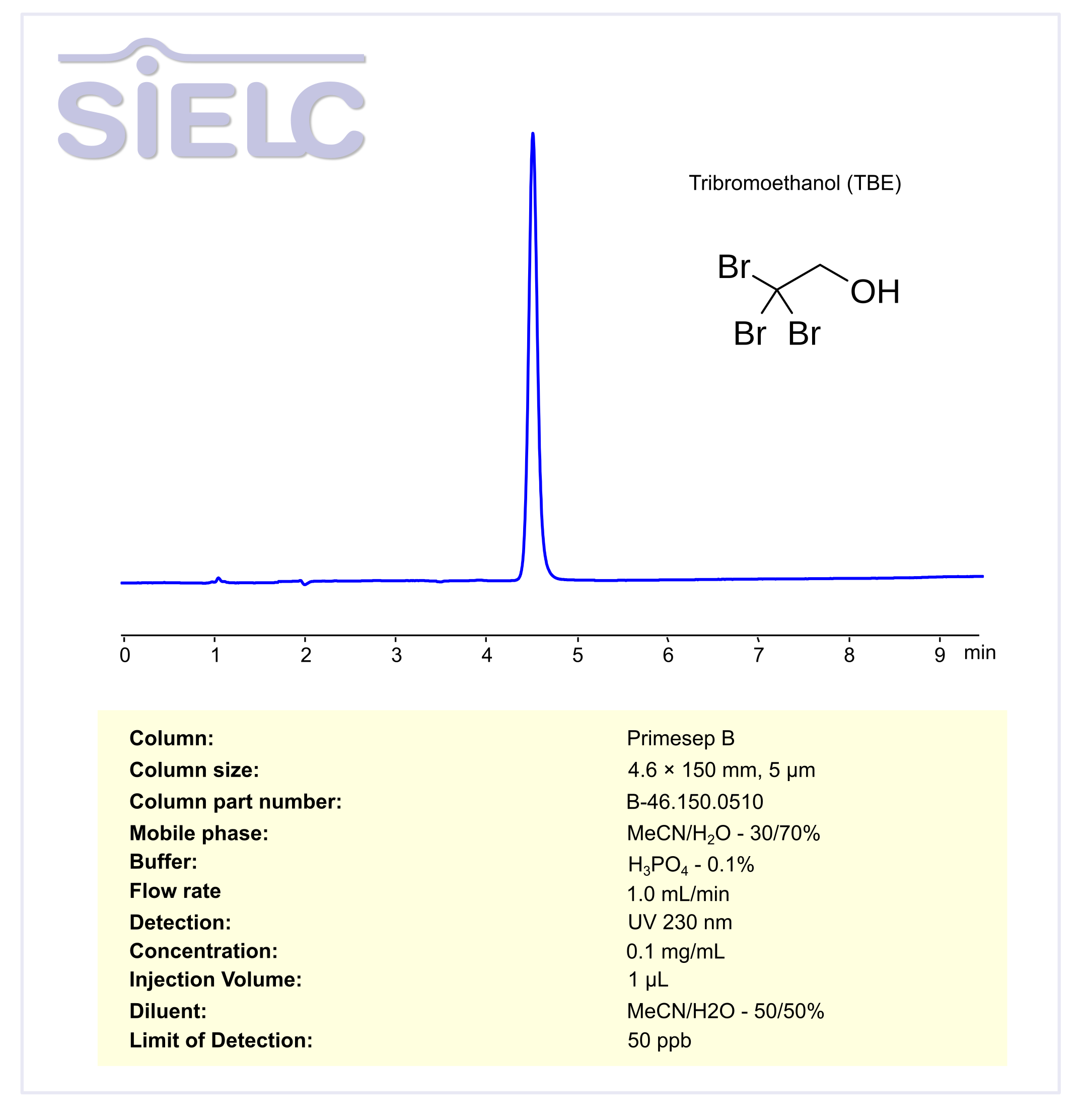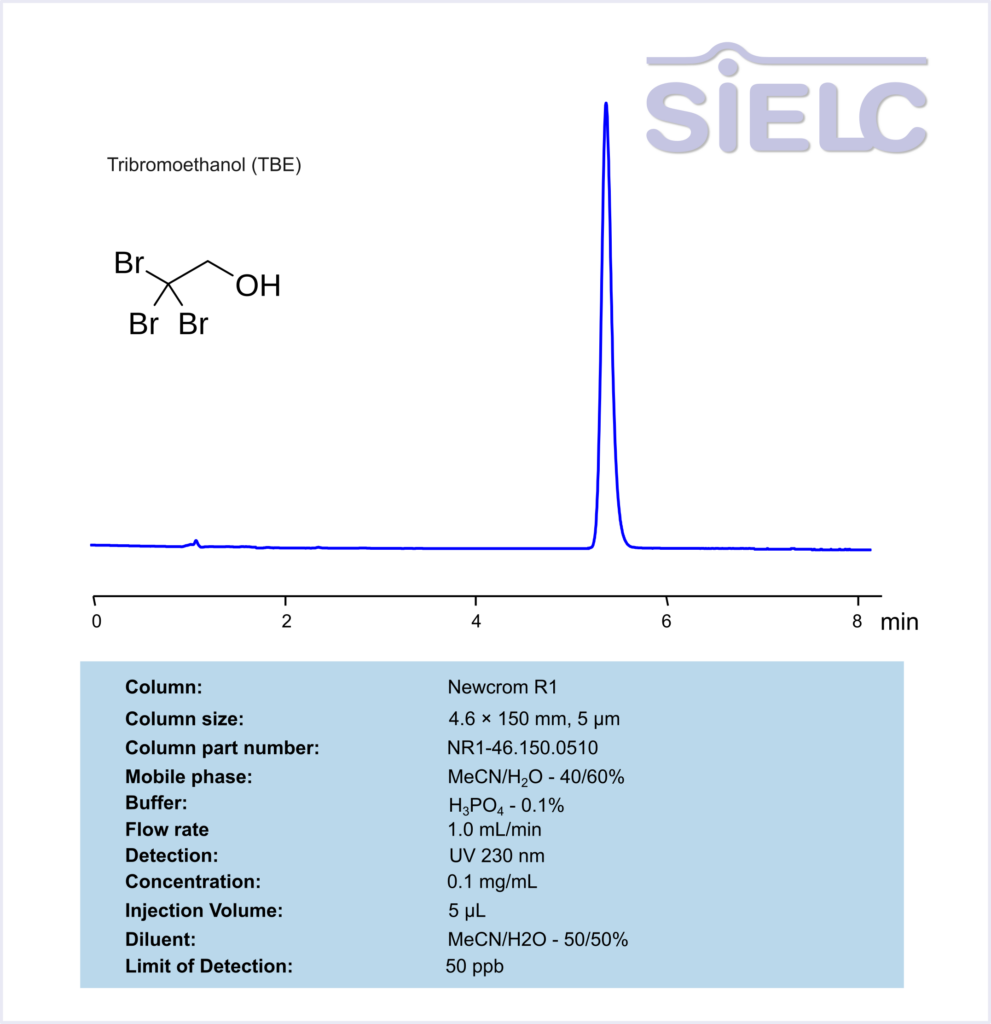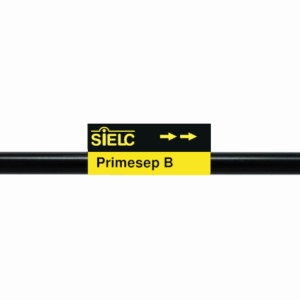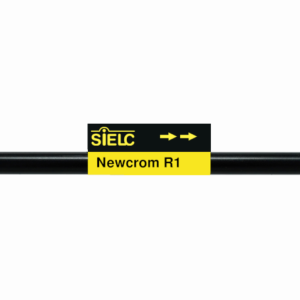| CAS Number | 75-80-9 |
|---|---|
| Molecular Formula | C2H3Br3O |
| Molecular Weight | 282.757 |
| InChI Key | YFDSDPIBEUFTMI-UHFFFAOYSA-N |
| LogP | 2.10 |
| Synonyms |
|
Applications:
HPLC Method for Analysis of Tribromoethanol (TBE) on Primesep B Column
February 4, 2025
HPLC Method for Analysis of Tribromoethanol (TBE) on Primesep B by SIELC Technologies

Tribromoethanol (TBE) is a chemical compound with the molecular formula C₂H₃Br₃O. It is a halogenated alcohol commonly used as an anesthetic agent in laboratory animals, particularly rodents.
Properties:
- Molecular Formula: C₂H₃Br₃O
- Molecular Weight: ~ 297.8 g/mol
- Appearance: White to off-white crystalline powder
- Solubility: Soluble in ethanol and some organic solvents
Uses:
- Anesthesia in Animal Studies: TBE is primarily used to induce anesthesia in small animals for short procedures. It is often prepared in a solution with tert-amyl alcohol or ethanol.
- Advantages: Quick induction and recovery, low cost, and ease of administration.
- Disadvantages: Can degrade into toxic byproducts if not stored properly and has a narrow safety margin in some species.
Tribromoethanol (TBE) can be retained, and analyzed using a Primesep B mix mode stationary phase column. The analysis utilizes a isocratic method with a simple mobile phase consisting of water, acetonitrile (MeCN), and phosphoric acid as a buffer. Detection is carried out using UV.
| Column | Primesep B, 4.6 x 150 mm, 5 µm, 100 A, dual ended |
| Mobile Phase | MeCN/H2O – 30/70% |
| Buffer | H3PO4 – 0.1% |
| Flow Rate | 1.0 ml/min |
| Detection | UV 230 nm |
| Class of Compounds | Acid, Hydrophilic |
| Analyzing Compounds | Tribromoethanol (TBE) |
Application Column
Primesep B
Column Diameter: 4.6 mm
Column Length: 150 mm
Particle Size: 5 µm
Pore Size: 100 A
Column options: dual ended

HPLC Method for Analysis of Tribromoethanol (TBE) on Newcrom R1 Column
February 4, 2025
HPLC Method for Analysis of Tribromoethanol (TBE) on Newcrom R1 by SIELC Technologies

Tribromoethanol (TBE) is a chemical compound with the molecular formula C₂H₃Br₃O. It is a halogenated alcohol commonly used as an anesthetic agent in laboratory animals, particularly rodents.
Properties:
- Molecular Formula: C₂H₃Br₃O
- Molecular Weight: ~ 297.8 g/mol
- Appearance: White to off-white crystalline powder
- Solubility: Soluble in ethanol and some organic solvents
Uses:
- Anesthesia in Animal Studies: TBE is primarily used to induce anesthesia in small animals for short procedures. It is often prepared in a solution with tert-amyl alcohol or ethanol.
- Advantages: Quick induction and recovery, low cost, and ease of administration.
- Disadvantages: Can degrade into toxic byproducts if not stored properly and has a narrow safety margin in some species.
Tribromoethanol (TBE) can be retained, and analyzed using a Newcrom R1 reverse-phase column. The analysis utilizes a isocratic method with a simple mobile phase consisting of water, acetonitrile (MeCN), and phosphoric acid as a buffer. Detection is carried out using UV.
| Column | Newcrom R1, 4.6 x 150 mm, 5 µm, 100 A, dual ended |
| Mobile Phase | MeCN/H2O – 40/60% |
| Buffer | H3PO4 – 0.1% |
| Flow Rate | 1.0 ml/min |
| Detection | UV 230 nm |
| Class of Compounds | Acid, Hydrophilic |
| Analyzing Compounds | Tribromoethanol (TBE) |
Application Column
Newcrom R1
Column Diameter: 4.6 mm
Column Length: 150 mm
Particle Size: 5 µm
Pore Size: 100 A
Column options: dual ended

Separation of 2,2,2-Tribromoethanol on Newcrom R1 HPLC column
February 16, 2018
2,2,2-Tribromoethanol can be analyzed by this reverse phase (RP) HPLC method with simple conditions. The mobile phase contains an acetonitrile (MeCN), water, and phosphoric acid. For Mass-Spec (MS) compatible applications the phosphoric acid needs to be replaced with formic acid. Smaller 3 µm particles columns available for fast UPLC applications. This liquid chromatography method is scalable and can be used for isolation impurities in preparative separation. It also suitable for pharmacokinetics.
Application Column
Newcrom R1
The Newcrom columns are a family of reverse-phase-based columns. Newcrom A, AH, B, and BH are all mixed-mode columns with either positive or negative ion-pairing groups attached to either short (25 Å) or long (100 Å) ligand chains. Newcrom R1 is a special reverse-phase column with low silanol activity.
Select options



